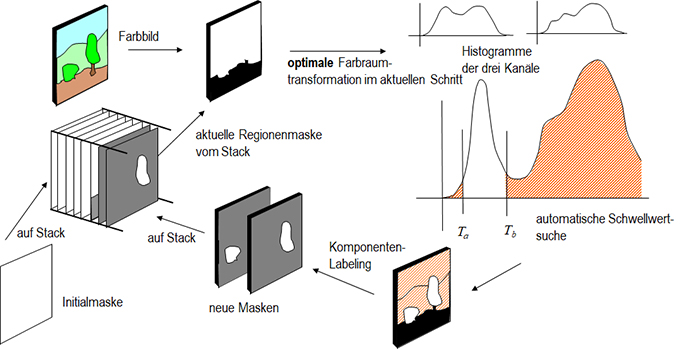Subject of the lecture Basics of Color Image Processing (Image Processing 2) are methods for solving image-based recognition problems in technical systems with color cameras or multi-channel imaging systems. Recognition tasks with camera-based (vision) technical systems are nowadays very common in automation technology, robotics, medical technology, surveillance technology and in the automotive sector.
The course focuses on multi-channel digital images using the example of images of the spectral image modality(color images), which are to be evaluated in terms of concrete tasks. The methods and procedures treated in the lecture are directly derived from known methods of grey scale image processing as treated in the lecture Basics of Image Processing and Pattern Recognition (Image Processing 1) or are newly developed considering the interrelations and the meaning of the colour channels (colour values) of an image. For this purpose, important basics of "colour" as a subjective sensory perception, of colour spaces and systems, of colourimetry are taught in the course and supplemented by knowledge of multispectral measuring and reproducing systems. The aim of image evaluation is the interpretation of the image content at different levels of abstraction. For this purpose, the images must be processed, transformed, converted, analysed and finally classified in the respective technically accessible form, in this case as a multi-channel (colour) image, in order to be able to derive relevant contents and statements. In the course, essential methods, procedures and algorithms are considered and discussed in the context of concrete applications from practice.
The student receives a comprehensive overview of the specifics of processing digital color images in the context of technical recognition tasks. In addition to the purely informatic aspects of image processing, the student is taught important connections to the emergence and technical description of the colour phenomenon and the technical capture in the form of digital colour images. As a result, the student is able to understand and design classical processing chains for solving image-based recognition tasks, to correctly classify and implement partial aspects of processing solutions, and to move conceptually confidently in this interdisciplinary field of knowledge. For the understanding of current application areas in this field, such as multispectral and multimodal image acquisition and image signal processing, important prerequisites are created by the lecture.
Building on the contents taught in the lecture, the student can use the acquired knowledge in further courses of the bachelor and master studies, e.g.
as well as further courses on applied image processing / artificial intelligence at the TU Ilmenau.
The course is accompanied by an exercise in which the lecture contents are reviewed and deepened and simple image processing tasks are worked on with a prototyping software for image processing solutions (VIP-Toolkit). Numerous teaching examples are provided for the lecture.



